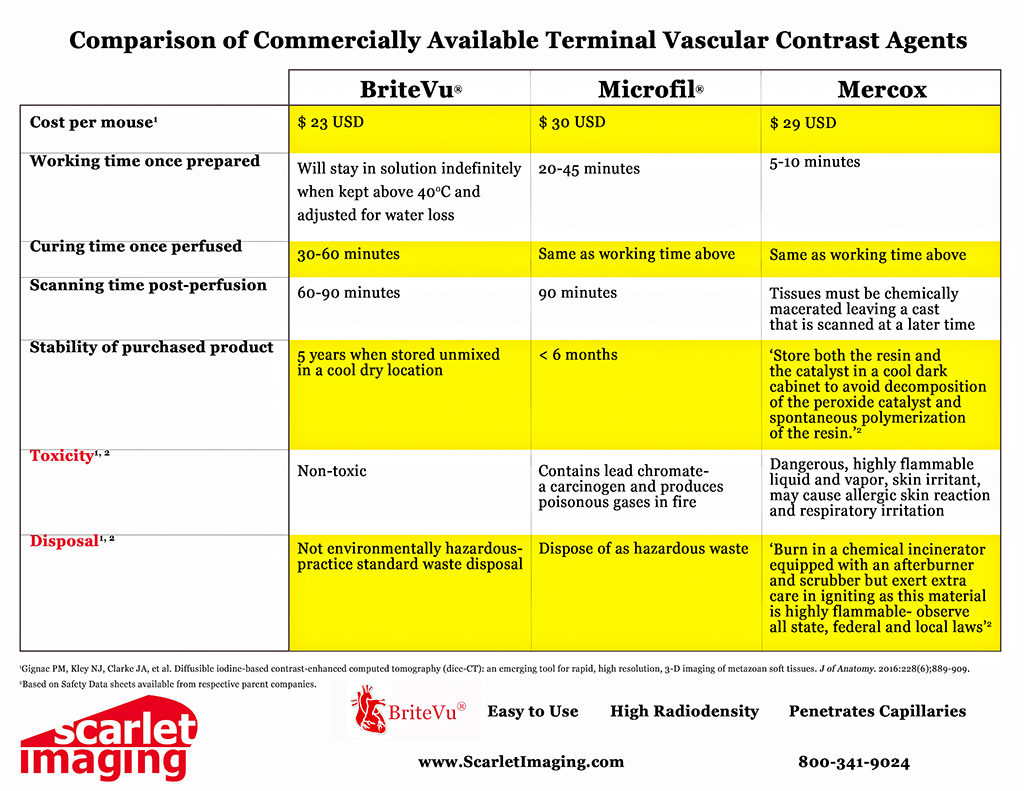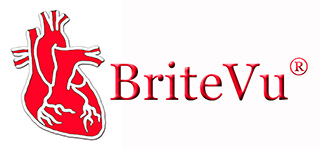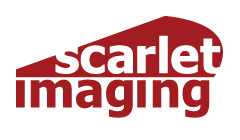
Comparison of commercially available terminal contrast agents.
There are several terminal contrast agents on the market, some of which have been around for decades. BriteVu® is relatively new and is distinctly different from other products. The following is a direct comparison between BriteVu® and the two leading competitor products Microfil® (Flow Tech Inc) and Mercox (Ladd Research Industries).

BriteVu®

Microfil® (Flow Tech Inc)

Mercox (Ladd Research Industries)
The information below has been obtained from Gignac PM, et al. Diffusible iodine-based contrast-enhanced computed tomography (diceCT): an emerging tool for rapid, high-resolution, 3-D imaging of metazoan soft tissues. J Anat. 2016;228(6):889-909, company websites and respective product Safety Data Sheet (MSDS or SDS). Dr Scott Echols is one of the co-authors of the above mentioned paper. Results are summarized in the Comparison of Commercially Available Terminal Vascular Contrast Agents PDF.
Table of contents:
- Product Ingredients and Toxicity
- Ease of Use
- Capillary Penetration
- Perfusion Subjects
- Cost
- Superior Results
Product Ingredients and Toxicity
BriteVu®
Radiodense Ingredient:
Barium sulfate.
Toxicity:
Barium sulfate is inert. BriteVu is non-toxic. BriteVu SDS.
Precautions:
Handle in accordance with good industrial hygiene and safety practice.
Disposal:
Standard waste disposal.
Microfil®
Radiodense Ingredient:
Combination of colored agents (titanium dioxide, lead chromate, lead acetate, cadmium mercury sulfide), diluent (silicone fluid) and curing agent (ethyl silicate and dibutyltindilaurate).
Toxicity:
Toxic if swallowed, ‘may be fatal if inhaled’, irritating to eyes and skin. Very toxic to aquatic organisms, may cause long-term adverse effects in the aquatic environment.
-Cadmium, mercury and lead all are associated with serious human and animal health effects.
Special Considerations:
Hazardous Decomposition Products: Carbon monoxide, carbon dioxide, formaldehyde, flammable hydrogen sulfide gas, sulfur dioxide gas, cadmium oxide fumes, titanium dioxide.
-‘In the presense of heat and organic matter, lead chromate can cause an oxidative reaction resulting in fire.’
-’Lead oxide fumes may be generated during fire conditions.’
-’Cadmium oxide fumes may be generated during fire conditions.’
-‘These fumes are severe pulmonary irritants and may be fatal.’
Disposal:
‘Do not empty into drains’.
‘Avoid release to the environment.’ (Dibutyltin dilaurate)
-’Incineration recommended’
-Dispose of as hazardous waste*
*Disposal guidelines are not clearly defined as there appears to be no safe means of disposal.
Mercox (Mercox II Resin)
Radiodense Ingredient:
Combination of methyl methacrylate, ethylene glycol dimethacrylate, bis(2-ethylhexyl) phthalate and a proprietary ingredient.
Toxicity:
Highly flammable liquid and vapour, causes skin irritation, may cause an allergic skin reaction, may cause respiratory irritation.
Precautions:
‘Harmful if swallowed, inhaled or absorbed through skin.’
Spill – Evacuate area. Shut off all sources of ignition. Wear self-contained breathing apparatus, rubber boots and heavy rubber gloves. Cover with an activated carbon absorbent, take up and place in closed containers.
Respiratory – OSHA or NIOSH approved respirator.
Gloves – Heavy rubber.
Eye – Chemical splash goggles or face shield.
Ventilation – Use in explosion-proof fume hood.
Special Considerations:
Hazardous Polymerization – May occur on exposure to light.
Conditions to avoid – Avoid heat and ignition sources.
Incompatibility – Oxidizing agents, peroxides, bases, acids, reducing agents, amines, halogens, heat.
Hazardous Decomposition Products – Toxic fumes of carbon monoxide and carbon dioxide.
Disposal:
Burn in a chemical incinerator equipped with an afterburner and scrubber but exert extra care in igniting as this material is highly flammable.
Ease of Use
BriteVu®
Preparation: Mix with water
-Can add phenol as preservative.
-Can add food coloring for color.
-Can add fluorescein for fluorescence.
Working Time: Will stay in solution indefinitely above 40oC. Just adjust for water loss.
Curing Time: 30-60 minutes once perfused. Best if subject is submerged in cold water post perfusion (speeds curing).
Scanning Time Post-Perfusion: 60-90 minutes.
Product Stability: At least 5 years when stored in a cool dry location.
Microfil®
Preparation: Mix radiodense solution with curing solution.
Working Time: 20-45 minutes.
Curing Time: Same as working time.
Scanning Time Post-Perfusion: 90 minutes.
Product Stability: < 6 months.
Mercox (Mercox II Resin)
Preparation: Mix resin and catalyst.
Working Time: 5-10 minutes.
Curing Time: Same as working time.
Scanning Time Post-Perfusion: Tissues must first be chemically macerated leaving a cast that is scanned later.
Product Stability: ‘Store both the resin and catalyst in a cool dark cabinet to avoid decomposition of the peroxide catalyst and spontaneous polymerization of the resin.’
Capillary Penetration
BriteVu®
Penetrates capillaries for whole body perfusion.
Microfil®
Penetrates capillaries with regional or local perfusion.
Mercox (Mercox II Resin)
Penetrates capillaries with regional or local perfusion.
Perfusion Subjects
BriteVu®
-Can be used on potentially any animal, from small to large, and has already been studied on a variety of birds, reptiles, mammals and even human cadavers.
Microfil®
-Primarily used on small rodents or small tissues.
Mercox (Mercox II Resin)
-Primarily used on small rodents or small tissues.
Cost
Back to top
Cost is per mouse based on published website prices
BriteVu®
$23
Microfil®
$30
Mercox (Mercox II Resin)
$29
Superior Results: BriteVu®
BriteVu®
At the end of the day, it all comes down to results:
-BriteVu® produces high radiodensity, complete perfusions and with fewer gaps resulting in outstanding vascular casts.
-Please take a look at the images under Research, Teaching and Images to see what BriteVu® has already done and what is possible for your research!
*DISCLAIMER:
Scarlet Imaging, LLC does not own trademarks or have any affiliation, sponsorship, or relationship with the competitors listed on this website. The information listed on this page is intended to be truthful and based on published factual information. Competitor products are recognized for their significant contribution to science and this comparison in no way is an attempt to malign the products, company or the people involved with their manufacturing.
